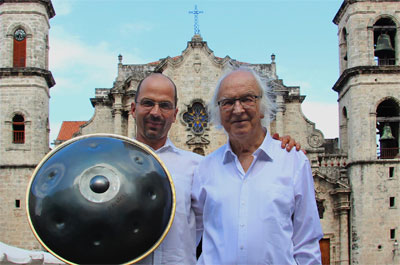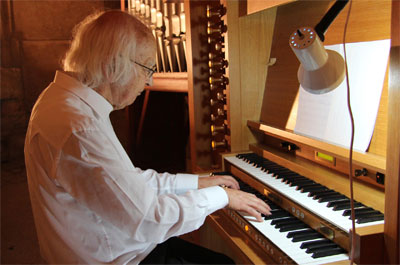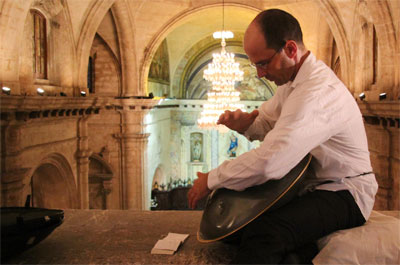Standing on the Edge of the Abyss
By Veronica Vega (Photos: Treche)

HAVANA TIMES – The Hindus pray to be always in the right place at the right time. From that perspective, I couldn’t have been anywhere else on the afternoon of February 2nd, but at the Cathedral in the center of old Havana.
I was there to see an unusual concert of a very atypical duo: Ananda Stephan* and Joseph Röösli, father and son, playing respectively the hang, a Swiss percussion instrument, and the organ.
The atmosphere was permeated with elation rather than religious fervor. The heterogeneous public included some tourists. I myself joked with some friends while I observed the exquisitely restored setting.
I looked around in vain for the organ, until the young Ananda informed us in the introduction that it was in the back, on a type of interior balcony on a middle floor, such that we could not see the musicians while they were playing their instruments.
This was slightly disconcerting, but within a few seconds I had already stopped thinking and questioning, as the organ began to vibrate and the first notes invaded the air. An almost suffocating emotion caused me to close my eyes, and forget everything around me.
With each pulsation of the organ my tears flowed in that sweet release that only the purest art can produce.
For a time, that even now I feel was measureless, Buxtehude, Pachelbel and Bach were the absolute owners of space and time through the work of that mysterious dimension that music opens to us.
In the second part of the program, the hang instrument was integrated into the music, an instrument whose sound reminds me of the traditional gong of India, but with a particular delicacy.
The hang marked the beat, calling – or rather I would say seducing – the organ that approached us with the heavy cadence of its footsteps, felt around, caressed us, and then faded into the distance, only to return in a wave that swept everything before it. It was impossible not to think, as Carlyle once said, that music, “takes us to the edge of the abyss and allows us to contemplate it for a few minutes.”
At the end of the concert I came forward to congratulate the musicians and was able to make an appointment with the organist. The next morning, in front of that same Cathedral, and several minutes before the Sunday mass, Joseph Röösli, his wife and their son Ananda, answered my questions with some help from Yusimi, my friend and HT colleague in a dialogue which leaped from German to English to Spanish.

HT: When did you begin to study music, and more specifically the organ?
Joseph Röösli: I began to play the piano when I was ten years old and the organ when I was fifteen. At eighteen I began to study organ at the School of Advanced Music in Switzerland. Later, I held various jobs as a musician: organist, choir director and music teacher.
HT: Is the organ a popular instrument in your country?
JR: Yes, it is.
HT: I suppose that this is kind of a stupid question, but just to hear it in your own words – Are you an admirer of Bach?
JR: Bach…[using an emphatic gesture to back up his words] is the pinnacle, the greatest of all.
HT: I could feel your devotion for Bach yesterday as you played him.
JR: Yes, yes
HT: How do you feel about your son’s work?
(Both Joseph and Ananda smile)
JR: I love music and also these new instruments which have a more folkloric sound. My son has travelled a lot, has seen a lot of other countries, and has spent time in India.
HT: How did the idea of playing together come about?
(Ananda intervenes here, admitting that it was his idea and adding his own thoughts, in reference to the CD “Hang & Orgel” which they interpreted in the second part of the program).
Ananda: The recording began as an improvisation. My father began to improvise on some themes that I was playing. But the organ that he plays in the recording is mechanical, not electronic like the one in this church, and has forty registers: for the flute, trumpet, oboe… It was built in 1694 and restored in 1914.

HT: There were moments yesterday when it seemed like you were holding back the organ a bit in order not to cover up the sound of the hang, and at other times it leaped forward and the organ covered up the hang, like a wave…
Both agree, and Ananda explains that in the recording he uses three microphones and an amplifier to compensate for the enormous resonance of the organ.
HT: Is this your first visit to Cuba?
JR: Yes.
HT: What are your impressions?
JR: It’s a very interesting place, and the people are very friendly. But I feel that the situation is very difficult for the majority.
At that instant the bells began to toll, calling people to mass. I addressed Joseph’s wife, asking her if she were also a musician. She confirmed that she studied the flute, but now she has retired as a performer and works as a professor of music. They spoke of the difficulties they had had in convincing the church to accept the idea of that concert, since the music did not seem “sufficiently religious” to them.
We took our leave of each other. With admirable simplicity, the great musician and his wife thanked us, while I insisted:
HT: No, no, we should be thanking you.
That night, I listened several times to the recording of organ improvisations that Joseph Röösli gave me. Like an extension of the concert the previous night, I thought how music is not only a great tranquilizer, but also a living force of regeneration.
I thought about Cuba, currently a land mine of rhythms steeped in violence, with lyrics that – beyond obscene – are empty, and where people not only free themselves emotionally but also learn how to become worse.
And I recalled the words of the Indian theosophist C. Jinarajadasa, on the need for “The State of the future [to] recognize that we are forming our citizens not only in the schools, but also and above all in the concert halls…”
—–
(*) See this related interview.





